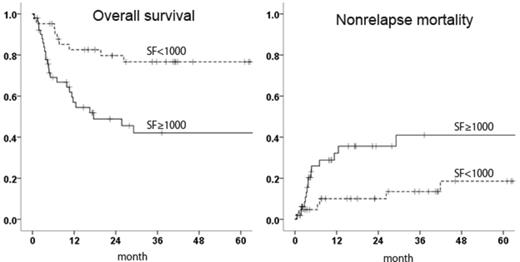Abstract
Previous studies showed an association between iron overload and hematopoietic transplant complications. Serum ferritin is widely used as an indicator for iron stores and an elevated pretransplantation level was strongly associated with inferior outcomes of transplantation in adults, though it has not been clarified well in pediatric patients. We studied prognostic impact of pretransplantation elevated ferritin levels on outcomes of allo-HSCT for pediatric hematological diseases.
We studied 93 consecutive pediatric patients (< 18 years old) with hematologic disease who underwent allogeneic HSCT at Osaka Medical Center and Research Institute for Maternal and Child Health between 2003 and 2009 in whom pretransplantation serum ferritin levels were available. The patients were divided into two groups, pretransplantation serum ferritin level ≥ 1000 ng/mL (SF≥1000) and ferritin level < 1000 ng/mL (SF<1000). Survival rate was estimated using the Kaplan-Meier method and compared between the two groups using the log-rank test. The association of pretransplantation ferritin and the transplant outcomes was evaluated in multivariate analysis with Cox proportional-hazards regression model.
At 5 years after transplant, children in SF≥1000 (n=51) had a significantly lower overall survival (OS; 42.1% vs 76.6, p=0.001) and a higher non-relapse mortality (NRM; 41.0% vs 18.6%, p=0.018) than those in SF<1000 (n=42). SF≥1000 (n=20) in patients with leukemia in nonCR had lower OS (14.4% vs 75.0%, p=0.051) than SF<1000 (n=5), whereas patients in CR had almost the same OS (65.8% vs 62.2%, p=0.920) between SF≥1000 (n=14) and SF<1000 (n=14), although the sample size was too small to detect statistically significant difference. Univariate analyses revealed elevated ferritin level, leukemia, nonCR, GVHD grade 3-4 and haploidentical donor as significant worse prognostic factors for OS and cord blood transplant as a significant better factor. In multivariate analysis, an elevated pretransplantation serum ferritin level was the only significant prognostic factor for worse overall survival [HR(95%CI): 2.35 (1.05-5.27), p=0.038]. There was no significant difference in the incience of acute GVHD, infection and any other complications as causes of nonrelapse death between the two groups, although the total incidence of fatal transplant-related complications was significant higher in SF≥1000.
Our results indicate that an elevated pretransplant serum ferritin level adversely affects outcomes of allogeneic transplantation in pediatric patients as reported in adults. The adverse impact of elevated ferritin levels on survival resulted from increased NRM. The association between high ferritin levels, which are usually caused by iron overload, and outcomes of transplantation in pediatric patients requires further prospective studies.
No relevant conflicts of interest to declare.
Author notes
Asterisk with author names denotes non-ASH members.



This feature is available to Subscribers Only
Sign In or Create an Account Close Modal